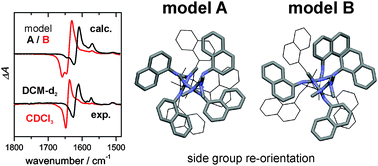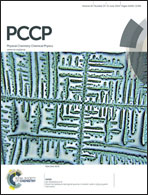Identification of the specific, shutter-like conformational reorientation in a chiroptical switching polycarbodiimide by VCD spectroscopy†
Abstract
The specific conformational states responsible for the unique, reversible temperature- and solvent-driven chiroptical switching process experienced by poly(N-1-naphthyl-N'-octadecyl-carbodiimide) (PNOC) have been identified using VCD spectroscopy and DFT calculations. The distinct VCD spectra of PNOC corresponding to the two specific conformations were obtained for the polymer dissolved in DCM-d2 (state A) and CDCl3 (predominantly state B). To specifically assign the structures of both conformations, two simplified 7mer models were constructed and optimized using DFT calculations. The theoretical spectra associated with these model conformations show a high level of agreement when compared to the experimental VCD spectra. The two states consist of the naphthyl pendant groups aligned directionally opposing the helical rotation (model A) and aligned with the helicity of the backbone (model B). This pendant reorientation causes very large OR and ECD Cotton effect inversions upon modification to the temperature or solvent composition of dilute (+)-PNOC solutions in specific solvents. In addition, the pendant group equilibrium from state A to B causes a contraction of the helical pitch from the more expanded 5/1 pitch to the more contracted 7/2 pitch resulting in increased disorder of the solvation sphere surrounding the polymer chain.


 Please wait while we load your content...
Please wait while we load your content...